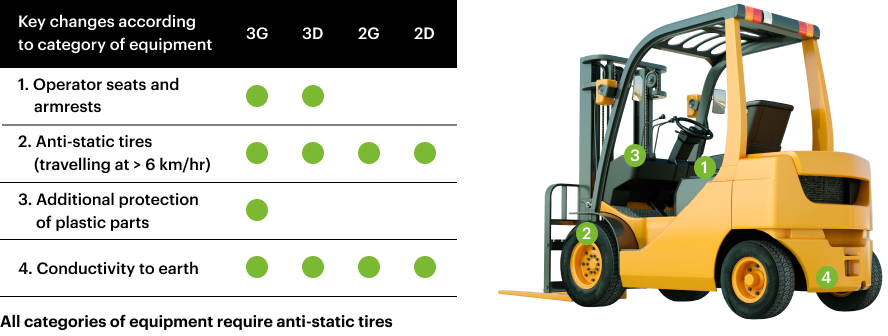Grafenske nanocevi za čvrste pneumatike koji ne ostavljaju tragove: usaglašenost sa elektrostatičkim zahtevima i zadržavanje mehaničkih osobina


Akumulacija statičkog elektriciteta u pneumaticima koji ne ostavljaju tragove može dovesti do povreda operatora, požara i oštećenja objekata.
Zbog toga su industrijske zone veoma strogo regulisane preko ATEX regulative i preko EN 1755 standarda, gde se ovaj poslednji odnosi na kamione koji se koriste u industriji (uključujući i njihove pneumatike) tokom rada u potencijalno eksplozivnim atmosferama za sprečavanje elektrostatičkog pražnjenja.
U skladu sa ovim standardima, ovaj tip proizvoda mora biti anti-statičan ili provodan.
| ATEX 2014/34/EU | EN 1755:2015 | ISO 3691-1:2011 |
|---|---|---|
| Oprema i zaštitni sistemi koji se koriste u potencijalno eksplozivnim atmosferama | Bezbednost u industrijskim kamionima. Rad u potencijalno eksplozivnim atmosferama. Koristite zapaljive gasove, paru, izmaglicu i prašinu | Industrijski kamioni. Bezbednosni zahtevi i verifikacija |
Novi elektrostatički zahtevi
EN 1755:2015
Obavezno: Novembar 2017
- Statika se sada smatra rizikom od paljenja tokom „normalnog“ rada
- Detaljnija procena ne-električnih komponenti je sada neophodna
Električne karakteristike:
- Površinska otpornost 109 Ω
Relevantne industrije:
- Hemijska
- Farmaceutska
- Hrana i piće
- Otpad
- Kozmetika
- Vojska
- Proizvodnja
- Logistika i ostalo

TUBALL™ grafenske nanocevi unapređuju fizičke i mehaničke osobine gume, doprinose zahtevanim anti-statičkim osobinama bez oslobađanja ugljenika, i u potpunosti su u skladu sa ATEX i EN zahtevima za ESD zaštitu.
TUBALL™ grafenske nanocevi se primenjuju preko TUBALL™ MATRIX koji se lako koristi, koji predstavlja liniju koncentrata na bazi polimer-nosača i plastifikatora i prethodno disperzovanih TUBALL™ grafenskih nanocevi.
TUBALL™ MATRIX za čvrste pneumatike
|
OSOBINE |
MATRIX 620.3 beta |
|
Kompatibilne formule |
NR- or NR/BR-based formulations containing mineral fillers |
|
Nosač koncentrata |
Polymer in oil-based plasticizer |
|
TUBALL™ GNT sadržaj, wt.% |
8.5% |
|
Obrada |
Nije osetljiv |
|
Doza koja je neophodna za anti-statičke karakteristike (105–107 Ω) |
Od 2.6 wt.% (0.22% TUBALL™) |
|
Mehaničke osobine |
Bez uticaja |
|
Električna otpornost |
Stabilno |
TUBALL™ grafenske nanocevi: Dobre performanse u svim ključnim parametrima
Za razliku od ostalih provodnih agenasa, TUBALL™ grafenske nanocevi su svestran provodni agens koji nudi dobre performanse u svim ključnim parametrima.
Rezultati testa: Mehaničke osobine

Stabilna električna provodljivost

Anti-statičke osobine bez oslobađanja ugljenika, za smese u boji koje ne ostavljaju tragove
REZULTATI ZA PNEUMATIK IZ KALUPA

Kada se koristi čađ, usled veće neophodne koncentracije (10% ili više) i sfernog oblika čestica, javlja se fenomen koji je u industriji poznat kao „oslobađanje ugljenika“, gde je provodni aditiv prisutan na površini uzorka.
Sa druge strane, grafenske nanocevi se, zahvaljujući svom većem odnosu dužine i prečnika, ne oslobađaju sa površine.
Marking and non-marking conductive rubbers: How to avoid mistakes
U situacijama u kojima je neophodno koristiti pneumatike koji ne ostavljaju tragove, bilo je nemoguće dodavati bilo kakve filere na bazi ugljenika – samo alternativni sastavi sa visokim mineralnim sadržajem su bili odgovarajući. Prema tome, anti-statički plastifikator je često korišćen u ovu svrhu u industriji.
Provodni plastifikator je materijal koji zavisi od vlage, tako da nije previše stabilan tokom upotrebe.
Da bi se postigle anti-statičke osobine, potrebna je visoka doza provodnog plastifikatora. Ipak, to ima negativan uticaj na fizičke i mehaničke osobine, naročito mehanički modul i zatezno izvlačenje. Pored toga, plastifikator ima tendenciju da migrira na površinu tokom čuvanja i upotrebe.
Degradacija mehaničkih karakteristika i migracija aditiva na površinu negativno utiče na performanse i upotrebni vek proizvoda.
Standardna oprema za obradu i mešanje
Optimalna opcija mešanja je kombinacija unutrašnjeg miksera i mlina sa 2 valjka.

Ostale prednosti
- Zadržana elastičnost i mehaničke osobine
- Veoma mala doza TUBALL™ MATRIX that preserves properties
- Zadržavanje boja
- Trajna i uniformisana električna provodljivost
Molimo vas da obratite pažnju na smernice za obradu za TUBALL™ MATRIX 620 i 620.3 beta za anti-statičke smese koje ne ostavljaju tragove
Preuzmite PDF verziju:
Primeri primene

NR/BR čvrste pneumatike koje ne ostavljaju tragove
Dodatne informacije
Non-marking solid tires: add nanotubes to meet ESD standards
Electrical resistivity guideline: measurement, standards & troubleshooting
Graphene Nanotubes Enable Creation of Non-Marking Anti-Static Tires
Graphene key to non-marking anti-static tires
Kontaktirajte nas da razgovaramo o specifikacijama vašeg projekta ili da poručite uzorak